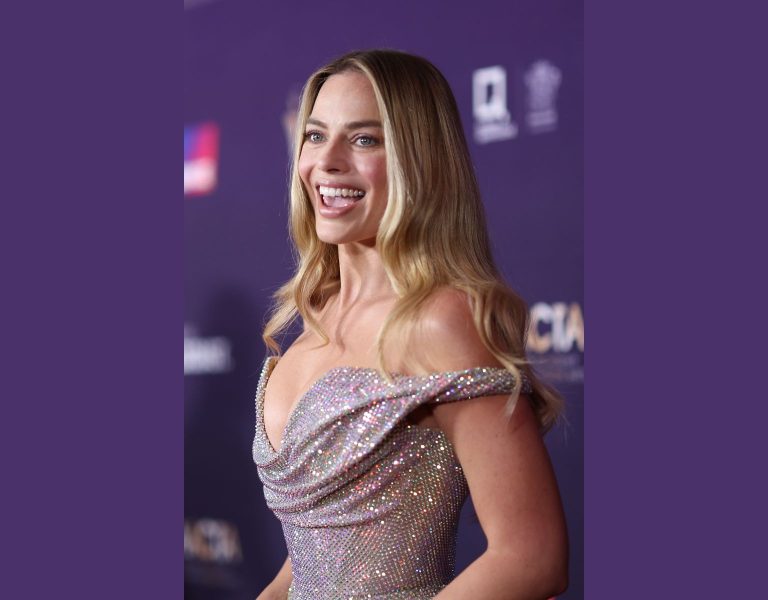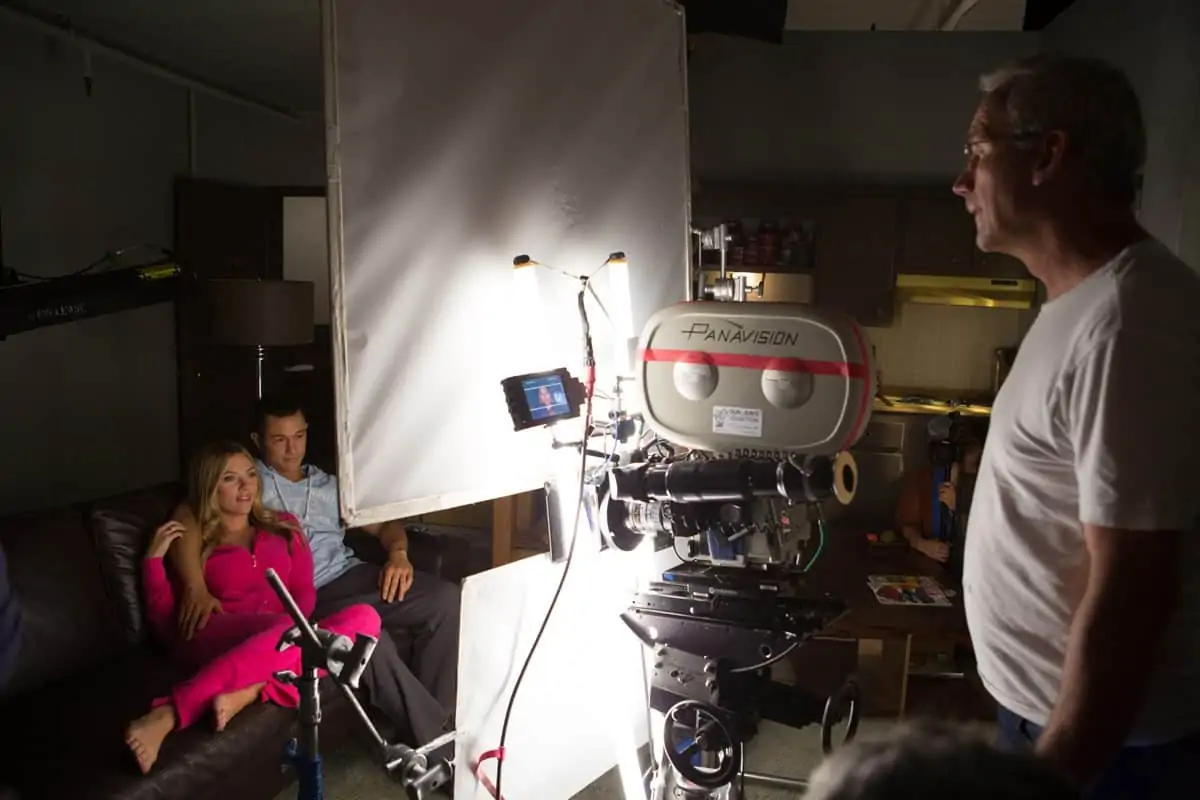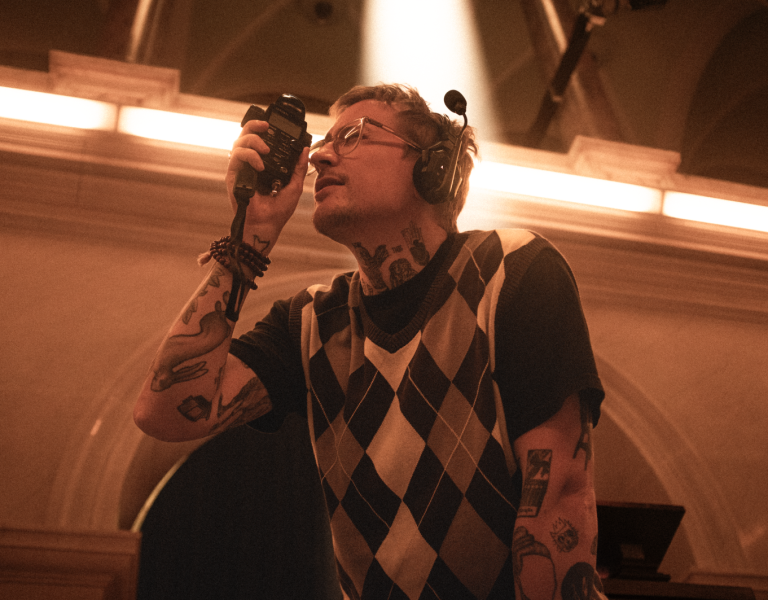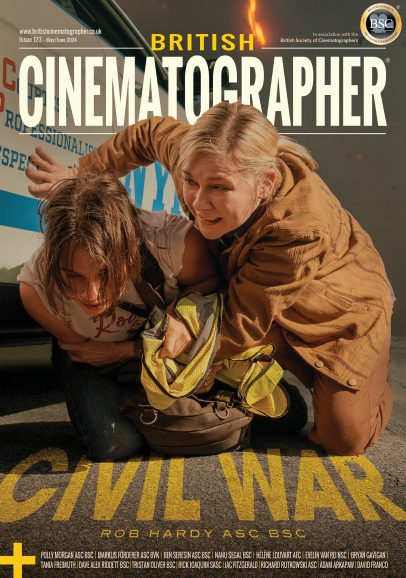CAPTURING THE UNIVERSE ON A SHOESTRING BUDGET
30-year-old Agfa film, a talking praying mantis, and a haunted Hoover. Director Vito Rowlands and cinematographer Thomas Heban were the masters of their own mythology in Rowlands’ poetic adaptation of the Metamorphoses.
We like to think of Ovid, New York, as a true New York indie. It was shot on a shoestring budget, with a skeleton crew, but it shoots for the stars. The fact that it is an anthology film – a kind of upstate “New York Stories” – plays into that moment of 80s/90s filmmaking as well. When Tom and I set out to make my first feature (which I also wrote and edited), we had already collaborated on quite a few short film projects. This includes the 16mm short silent thriller Into the Silver Ether (2020), which we shot on a Bolex H16 Rex 5 on Kodak TRI-X black and white reversal stock, and that I hand processed at Brooklyn cinema-arts non-profit Mono no Aware – they are a great supporter of our work, and I am also an instructor there.
Ovid, New York paints a picture of violence and catharsis that is anchored in mythical landscapes. The film’s seven tales of transformation range in tone from crimson surreal to the darkest of comedy, playfully shifting moods, genres, and seasons without losing sight of its overarching mythology.
Film stock came into play as we addressed one of the first challenges for the film: how can we create a universe that exists outside of time? The film’s seven chapters are myths for modern times, allegories that tap into a violent, beautiful, and mysterious yet universal world, and we wanted to transform locations into spaces where the lines between our world and the liminal are exceedingly blurry and often crossed.
This is where Steve Cossman at Mono No Aware stepped forward and offered us the opportunity to work with 35mm Agfa XT100 colour negative stock that they had on the shelf. A little research indicates that Agfa introduced this stock in 1992 and that they stopped making colour negative stock altogether in 1995. Bracket exposure tests on each can reveal a unique colour palette that skewed wonderfully towards reds and blues, and we rated the 100 ISO film at 25 ISO. This ended up being our guideline for shooting, and it was a real challenge making it work in the winter, in interiors, and on a night shoot with the very limited few lights we had at our disposal. Luckily, we had a highly supportive film lab partner in Colorlab, who really pulled through for us.
In keeping with Ovid’s Metamorphoses, we followed the changing seasons for an entire year, and we shot across New York State’s beautiful mountain ranges, valleys, rivers, lakes, and ponds. We embraced these landscapes by shooting 2-perf (for a 2.4:1 Techniscope ratio), which also fit in with a lot of our 1960s-1970s inspirations. Like most of my other work, Ovid, New York is a film that draws attention to its own materiality. In this case, the living, breathing textures of our long-expired stock. We leaned into the stock’s characteristics and flaws, and embraced and foregrounded artifacts such as remjet stains and flash frames. We bleach-bypassed one chapter to add more contrast and texture, and the film opens and closes with long takes at magic hour that show just how mystical the stock is. The film really aims to mirror its characters. It is complex, flawed, mysterious, textured, and, most of all, alive. It adds a crucial layer of magical realism to the film.
Our first chapter takes a cue from Sergio Corbucci’s snow western Il Grande Silenzio (1968). It opens on an oil painting created by the great Amaya Gurpide that slowly dissolves into our opening shot: a long take of a car snaking up a snow-covered mountain at the break of day. The chapter was shot in -20C temperatures on an Arriflex BL4 with an Angénieux Optimo Style 25-250mm T3.5 zoom lens, a 24mm Rokinon Xeen prime T1.5, and a vintage Soviet Jupiter-9 85mm T2.1. The chapter follows a bounty hunter hired by the goddess Diana to kill men she once transformed into animals for defiling her honour. The main culprit, Actaeon, was transformed into a deer, and so we spent quite a bit of time tracking down deer on the 250mm end of our zoom, patiently awaiting the right nod of the head to make it work in the edit.
It was this chapter that earned us Panavision New York’s New Filmmaker Grant, through which the exceedingly supportive Chris Bieler and Chuck Valencia and their team supplied us with a Panaflex Gold GII 2-perf camera, Primo Prime lenses, and additional gear as needed. Our shoots necessitated 35mm cameras with 1,000 ft. magazines – since we had no infrastructure to spool the cans down – which made the camera incredibly heavy. Between our 5-man crew – loader and 1st AC Gregory John Fitton, production sound recordist Andrew Mazzei, co-producer Hash Sesay, and Tom and myself – a lot of time was spent hiking and cart-pulling the camera to gorgeous but hard-to-reach offroad locations.
Because every chapter has a different tone, genre, and aesthetic inspiration, we diversified our approach quite a bit. Our final chapter, which shows twin ferrymen Karon and Charon (Max and Nicholas Weinbach) guarding the underworld, was shot in autumn with a 14.5mm T1.9 Panavision Primo and pays homage to both Alfred Hitchcock’s The Trouble with Harry (1955) and Jean-Luc Godard’s Pierrot le Fou (1965). Tom and I opted to roll the dice and bleach bypass the dream-logic, René Magritte-inspired chapter about a Hoover salesman haunted by his hotel room – and by 200 giant teal hornworm caterpillars that my wife hand raised to co-star. We shot it entirely on a 40mm lens save for macro shots of the caterpillars and a few zoom shots through the windshield of a car to create a Vertigo effect.
Our middle chapter stands out because it was shot on a Bolex with prime lenses in soft black-and-white 16mm – slightly overexposed 400-speed Orwo N74 stock – that was later hand processed, in combination with Kodak Ektachrome 100D colour reversal Super 8 stock that was shot on a Canon Autozoom 1014. The chapter is the only one from the perspective of a god on Olympus. It acts as both a palate cleanser and an intermission from the other chapters’ perspectives. Smaller gauges seemed appropriate to embrace the more experimental approach I took towards it in writing and editing.
As you can tell from these descriptions, animals populate both the Metamorphoses and Ovid, New York. They are charmed vessels through which gods communicate and manifest themselves, never showing us their true form. Watching the film, you will run into enchanted deer, beetles, cicadas, mantids, caterpillars, butterflies, and even a petrified centaur, all of which we proudly wrangled ourselves.
One chapter that posed a particular challenge dealt with an entomologist (played by April Matthis) who hits her head and receives a visit from a talking praying mantis named André, who suggests she kill her ailing mother. We got the mantis (dubbed “Mel”) off Craigslist in New Jersey, and it needed constant feeding to keep it still for the camera. We turned that attribute into a nod to Brad Pitt’s character in the Ocean’s films when we did ADR for it. To embrace the worlds of men and gods colliding in this fashion, we used a split-focus diopter for almost all shots in this chapter, which also allowed us to create compositions in which April Matthis and the mantis are in the same frame talking to one another. A macro 50mm lens came in handy for our mantis close-ups as well. We also gave this chapter additional exposure compensation, not just for the final slow-motion dance sequence inspired by Mother (Bong Joon-ho, 2009), but also for the night shoot in which our character goes mothing, and for the chapter’s overall Technicolor, uncanny valley feel.
Ovid, New York, truly was a dream collaboration. Not just between the set team of Tom, myself, Greg, Andrew, and Hash, but also with our team on the post-production side: our stellar composer and frequent collaborator Jordan Dykstra and our sound designer Joe Tisdall, first and foremost. Apart from our opening painting by Amaya Gurpide, Mat Rousso also hand-painted all the titles for the film. And there was, of course, also the stellar cast of New York actors that graciously lent their time and talents, as well as Mono No Aware, Colorlab, and Panavision, without whom we would never have been able to create this unique world on 35mm. We are hoping to present the film in the UK and Europe soon, and are also in pre-production on our second feature together, which will be a silent, nineteenth-century set spiritualist thriller which we aim to shoot on 16mm and hand process.












